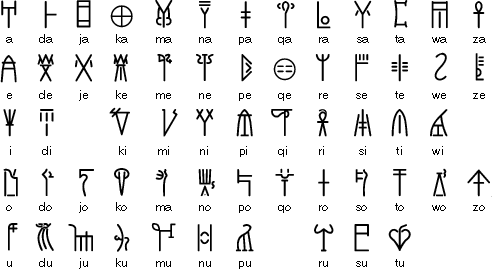Tigerlily wrote:The Lebanese need to go easy on the whole Phoenician thing.
It generally strikes me as very odd into how many modern nations who have no historical memory(.ie linear written records demonstrating their ethnic presence), for example historical protocol if you understand what am saying, nor any sign of linguistic evolution claim ancient origins based on geography and loudly so.
Another thing that is striking is the widespread mainstream acceptance of Phoenician as the mother of all alphabets, when many gigantic scholars argue the contrary and credit Crete instead which based on archeological evidence it is quite obvious even for the layman let alone the scholar. Sir Arthur Evans, Auguste Jardé, Dussaut are a few that I have personally come across. Linear A, and B scripts which are syllabary scripts like the Phoinician and not proper alphabets predate archeologically the Phoinician and the Sinaitic scripts resemble them to a great degree but are not even included in the evolution of scripts!
We have a syllabic writing system in Crete factually much older than the one which is considered "mother", it has got identical letters, it is used by Greeks to write Greek, and the story goes that Greeks abandon this syllabic script and in order to make their own they adopt another foreign one which is identical to theirs, add the vowels and voila the first proper alphabet of the planet.

We know that the Cretans colonized the Levantine schores, in fact the oldest archeological items in the territory are Mycenean and Aegean pottery, but their script is irrelevant to writing systems...when it resembles them and predates them?
Anyhow the facts are:
1) The first alphabet in the world is the Greek alphabet(.iw a writing system with both vowels and consonants)
2) The oldest syllabary(Phoinician, Sinaitic, Linears) is the Cretan syllabary not the Phoinician.
3) These syllabaries resemble each other to an astonishing degree.
4) Crete was an advanced civilization prior to the Levant and spread its pottery throughout the shores.
The math are there however it is true that mainstream scholarship dogmatically parrots the dependency of the Hellenic alphabet to the Phoinician. That though does not deny the aforementioned facts and at this point it is up to the judgement of the reader to make out.
I am fairly convinced of my case, you even at the absence of any personal research are going to parrot wiki sentences so, am going to leave it here. There used to be in PoFo a student of linguistics who has studied the Linear scripts, who admits that more gravity ought to be given to the subject of syllabary evolution and the role that the Liners played, which are altogether ignored.
There are many more scholars pointing to this view and a more systematic analysis of my argument in an old thread. You might want to read it
here.
Snippets:
a) Archaeological Evidence
The theory that the alphabet is a Phoenician discovery has been maintained through the argument, among other things, that certain symbols of Phoenician writing are similar to the letters of the alphabet. For example, the Phoenician alef is the reverse or sideways Greek "A." This argument was a strong one until about 100 years ago, when linguists and historians still maintained that the Greeks did not know how to write before 800 B. C.! Around 1900 A.D., however, Arthur Evans excavated the Greek Minoan Crete and discovered the Greek Linear writings, whose symbols corresponded to 17 of the 24 letters of the Greek Alphabet.
Given that (A), the most ancient evidence of the Greek scripts (Linear A and Linear B) that were later discovered in Pylos, Mycenae, Menidi and Thebes -- but also in more northern areas up to the Danube river as well -- were dated to before 1500 B.C. And (B), that the Phoenicians and their writings appear in history no earlier than 1300 BC, Evans was the first person to express doubts about the theory that the Greeks received their script from the Phoenicians. He put forward the scientific suspicion that it was probably the other way round.
The doubts pertaining as to who was first -- the Phoenicians or the Greeks -- in discovering writing, became a certainty when French professor, Paul Fore, an internationally acclaimed specialist on Prehistoric Archaeology, published a report in Nestor (an American Archaeological Journal of the University of Indiana -- 16th year, 1989, page 2288). In this report, he submits and deciphers plates with Greek Linear writing found at the cyclopean wall of Pilikates, in Ithaca, dated, through the use of modern scientific methods, back to 2700 B.C., The language of these plates was Greek, and the decoding by professor Fore resulted in the following syllabic text, expressed phonetically: A]RE-DA-TI. DA-MI-U-A-.A-TE-NA-KA-NA-RE (ija)-TE. The phonetic equivalent of this is translated, always according to the professor, as: "Ιδού τι εγώ η Αρεδάτις δίδω εις την ανασσαν, την θεάν Ρέαν: 100 αίγας, 10 πρόβατα, 3 χοίρους" [Here is what I, Aredatis, gives to the queen- goddess Rea, 100 goats, 10 sheep, 3 pigs]. (See, "Davlos" magazine, issue 107, November 1990, page 6103). Thus, Fore proved that the Greeks were writing and speaking Greek at least 1400 years before the appearance of the Phoenicians and their script in history.
But, the archaeological excavations in Greece during the last 15 years have given us many more great surprises: The Greeks were writing using not only Linear A and B, but also a type of writing identical to that of the alphabet since at least 6000 B.C. In fact, at Dispilio, in the lake of Kastoria, in northern Greece, professor G. Houmouziadis discovered a plate with writing very similar to that of the alphabet, which was dated, using radioactive Carbon-14 and visual photothermal methodology, back to 5250 B.C. (see Davlos, issue 147). Three years later, N. Samson, a curator of the Prehistoric and Classical Antiquities Department, discovered shards of vases ("ostraka") with letters identical to the present Greek alphabet while excavating at the "Cyclop’s Cave," on the deserted island of Yioura, near the inhabited island of Alonnissos, in the Northern Sporades island complex. These vases were dated to 5,500 to 6,000 B.C. with the same methods (see "Davlos," issue 185, May 1997). The same archaeologist, while performing excavations on the island of Milos, discovered vessels of the proto-cycladic period (mid-3rd millennium B.C.) with letters identical to the Greek letters: "X," "N," "M," "K," "Ξ" [ksi],"Π" [p], "Ο," & "Ε." (See N. Samson's interview in Davlos, issue 204, December 1998, page 12749.)
It is apparent that these archaeological discoveries have given a "comical' character to the so-called "Phoenician Theory" on the discovery of writing. In addition, these archaeological discoveries have revolutionized chronological dating of Greek history as it is taught today, as well as the world history of civilization itself. (See also the book by Con. Koutrouvelli, "Re-establishing the Chronology of Prehistoric Times based primarily on astronomical information from Ancient Writers," Davlos Publishing, 1999.)
b) The somewhat mathematical proof
While the house-of-cards which provided "proof"' of the so-called "Phoenician alphabet" was being torn down by archaeological discoveries, another overwhelming piece of evidence surfaced. This evidence was offered to us by the 20-year long discreet and timid research of the Greek Language and Writing by a great researcher, Elias Tsatsomoiros. Unfortunately E. Tsatsomoiros passed away on December 19th 1991, after having, however, completed his revolutionary work, History of the Genesis of the Greek Language-from the hunter-gatherer to the time of Zeus-the Deciphering of the Greek Alphabet. The undersigned [writer of this article] had the honor of publishing and editing this work (Davlos Publishing, 1991), but also the honor of having worked closely with the researcher for more than a decade. We had long discussions on the numerous problems arising from the research, and we had published a series of articles in Davlos magazine. This memorable researcher proved in a remarkable way that every letter of the Greek alphabet contained a consistent code meaning, which is literally introduced either exactly or metaphorically within the general meaning of the Greek word it belongs to, as a partial meaning. Consequently, every (ancient) Greek word is basically an acronym (similar to D(imosia) E (picheirisi) H(lektrismou) [=ΔΕΗ in Greek, or as U(nited) N(ations), in English], where every letter provides a significant or less significant notional element, and then, they all together provide the logical definition of the meaning expressed by the word. The "significant difference" of each word's meaning is usually provided by the first letter.
Obviously, there is not enough space in this article to present the code meaning of the letters of the Greek alphabet as a whole, as they are analyzed in this revolutionary volume of research in the field of human speech. As an example, I will choose only one of the 24 letters of our alphabet, "Ypsilon" = "Y" or, small case, "u" (pronounced, long-e "eepsilon," the 20th letter of the Greek alphabet, and familiar to us as "Y" in the so-called "Latin" alphabet-- which is nothing more than a variation of the Greek "Chalcidean" alphabet). Ypsilon, therefore, as its shape indicates, has the code meaning of "a cavity" οr, if reversed, of a "convexity." This meaning is introduced into the words containing this letter, and sometimes, by extension into the meaning of liquids (which, through their natural flow end up filling the "cavity"). I will quickly mention some of the names of vessels and liquids (such as the amphiconical κ-Υ-πελλο which is dated back to 2700 B.C. and is displayed at the Heraklion Museum). One may add to the words mentioned there, many others, such as kot-Y-li, go-Y-ttos, tr-Y-blion, p-Y-xis, amphore-Y-s, b-Y-tion, l-Y-chnos, procho-Y-s, ske-Y-os, etc, all having the meaning of a curved object. Also, some other words such as k-Y-hsis (rounding of the stomach of an eng-Y-os [pregnant] woman); k-Y-ma (curving on the surface of the ocean); cr-Y-pti (curving of the ground); the preposition [h-Y-po] Y-po (meaning under a certain level); h-Y-per (preposition meaning above a certain level); Y-psos =height; and all of the hundreds of words that have h-Y-po or h-Y-per as a prefix, as well as thousands of others. This discovery, which unfortunately has been officially ignored, is a continuation of the forgotten Platonic approach to the problem of language (see Plato’s Cratylus ).
In regards to the second argument, there is no such connection between Phoinician letters and meanings, because it is essentially the creator that defines the code according to his phonemes.
EN EL ED EM ON

...take your common sense with you, and leave your prejudices behind...












 (i'm not a Phoenician though!my forefather moved to Lebanon in the 1940's)
(i'm not a Phoenician though!my forefather moved to Lebanon in the 1940's)



 - By Doug64
- By Doug64 - By JohnRawls
- By JohnRawls - By Fasces
- By Fasces